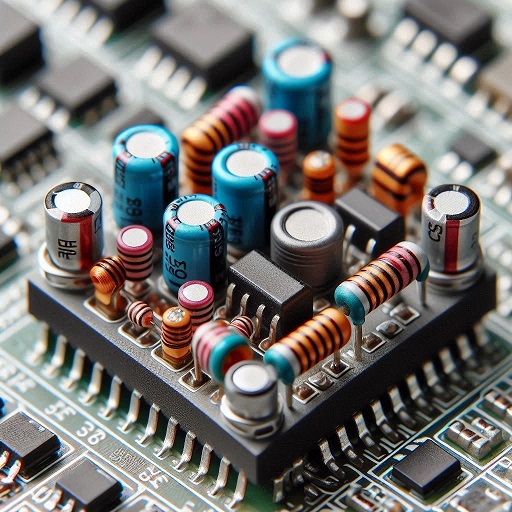Radio Frequency (RF) components are essential to modern communication systems, powering technologies in sectors from telecommunications to defense. As global demand for wireless and high-frequency technologies grows, the RF component market is experiencing rapid expansion. In this article, we’ll explore the market’s growth drivers, challenges, and future outlook, providing a comprehensive understanding of this dynamic sector.
RF components include amplifiers, filters, antennas, switches, and oscillators, which handle frequencies ranging from 3 kHz to 300 GHz. These components are critical for wireless communications, such as Wi-Fi, Bluetooth, cellular networks, and satellite communications. Their versatile applications span industries including automotive, telecommunications, defense, healthcare, and consumer electronics.

Key Growth Drivers
Several key factors are propelling the RF component market forward. These include advancements in wireless communications, rising demand for connected devices, and global investment in telecommunications infrastructure. As demand increases, RF components continue to innovate, offering more efficient and smaller-sized solutions.
Download PDF Brochure @ https://www.marketsandmarkets.com/pdfdownloadNew.asp?id=234495624
RF Signal Chain Components Market Size & Share
The global RF signal chain components market is expected to reach USD 80.0 billion by 2028, growing at a compound annual growth rate (CAGR) of 12.3% from 2023 to 2028. This growth is primarily driven by the rising number of smartphone and mobile phone users, which has increased demand for RF signal chain components essential in mobile devices. As mobile connectivity continues to expand globally, the RF signal chain component industry is set to experience substantial growth.
Technological Advancements
The RF component industry has witnessed substantial technological advancements, including the development of GaN and GaAs semiconductors, which provide higher performance than traditional silicon-based materials. Other innovations include miniaturization techniques, integration of AI for optimized signal processing, and advancements in MIMO (Multiple Input, Multiple Output) technology, which enhances wireless network capacity and efficiency.
Increasing Demand for 5G Infrastructure
5G infrastructure requires extensive deployment of RF components for enhanced connectivity, speed, and bandwidth. RF components, such as filters and amplifiers, play a crucial role in handling the frequency bands utilized by 5G networks, propelling their demand as countries continue to roll out 5G technology worldwide.
IoT Proliferation
Impact of IoT Growth on RF Component Demand
The growth of the Internet of Things (IoT) has led to an explosion in connected devices, all of which rely on RF components to transmit data wirelessly. From smart homes to industrial automation, IoT applications are generating substantial demand for high-performance, low-power RF components that can operate efficiently in various conditions.
Automotive Industry Demand
Rising Use of RF Components in Connected Cars
The automotive sector’s shift toward connectivity, autonomous driving, and electric vehicles has increased the use of RF components in vehicles. These components enable vehicle-to-everything (V2X) communication, providing safety features and enhancing navigation, entertainment, and telematics systems.
Aerospace and Defense Sector
Role of RF Components in Military and Defense Applications
RF components are fundamental to the aerospace and defense sectors, where they support communication systems, radar, and electronic warfare technologies. As defense budgets grow globally, especially for advanced RF-based equipment, this sector remains a key driver for RF component demand.
Emerging Markets and Opportunities
Regional Analysis of Growth in Emerging Economies
Emerging markets, particularly in Asia-Pacific, are experiencing high demand for RF components due to expanding telecommunications infrastructure and the adoption of new technologies. These regions present significant opportunities for growth as governments invest in 5G, IoT, and digital transformation initiatives.
Environmental and Regulatory Challenges
Impact of Regulations on RF Component Market Growth
The RF component market faces various environmental and regulatory challenges, especially concerning spectrum allocation, emissions, and waste management. Compliance with these regulations is essential to market growth but may also create operational and cost challenges for companies.
Supply Chain Constraints
Analysis of Supply Chain Issues Affecting Market Expansion
Global supply chain constraints, including semiconductor shortages and raw material scarcity, have impacted RF component availability and pricing. These issues challenge manufacturers and influence pricing and availability in the global market.
Future Prospects
The future of the RF component market is promising, with continued growth anticipated due to technological advancements, especially in 5G and IoT. However, success will depend on overcoming challenges such as regulatory compliance, supply chain stability, and competitive pressures.
The RF component market is growing, driven by advancements in technology, increased demand for connectivity, and applications across industries. While the sector faces challenges from regulatory and supply chain constraints, its future outlook remains optimistic.
FAQs
1. What are RF components used for?
RF components are used in wireless communication, including cellular networks, Wi-Fi, Bluetooth, and IoT applications.
2. How does 5G impact the RF component market?
5G infrastructure requires RF components to handle high-frequency bands, increasing their demand.
3. What challenges does the RF component market face?
Key challenges include regulatory compliance, supply chain constraints, and cost factors.
4. Which industries use RF components the most?
Industries such as telecommunications, automotive, aerospace, and defense are major consumers of RF components.
5. What role do RF components play in IoT?
RF components enable IoT devices to communicate wirelessly, supporting the growth of connected devices.
6. Who are the major players in the RF component market?
Leading players include Qualcomm, Broadcom, Analog Devices, and Texas Instruments.
